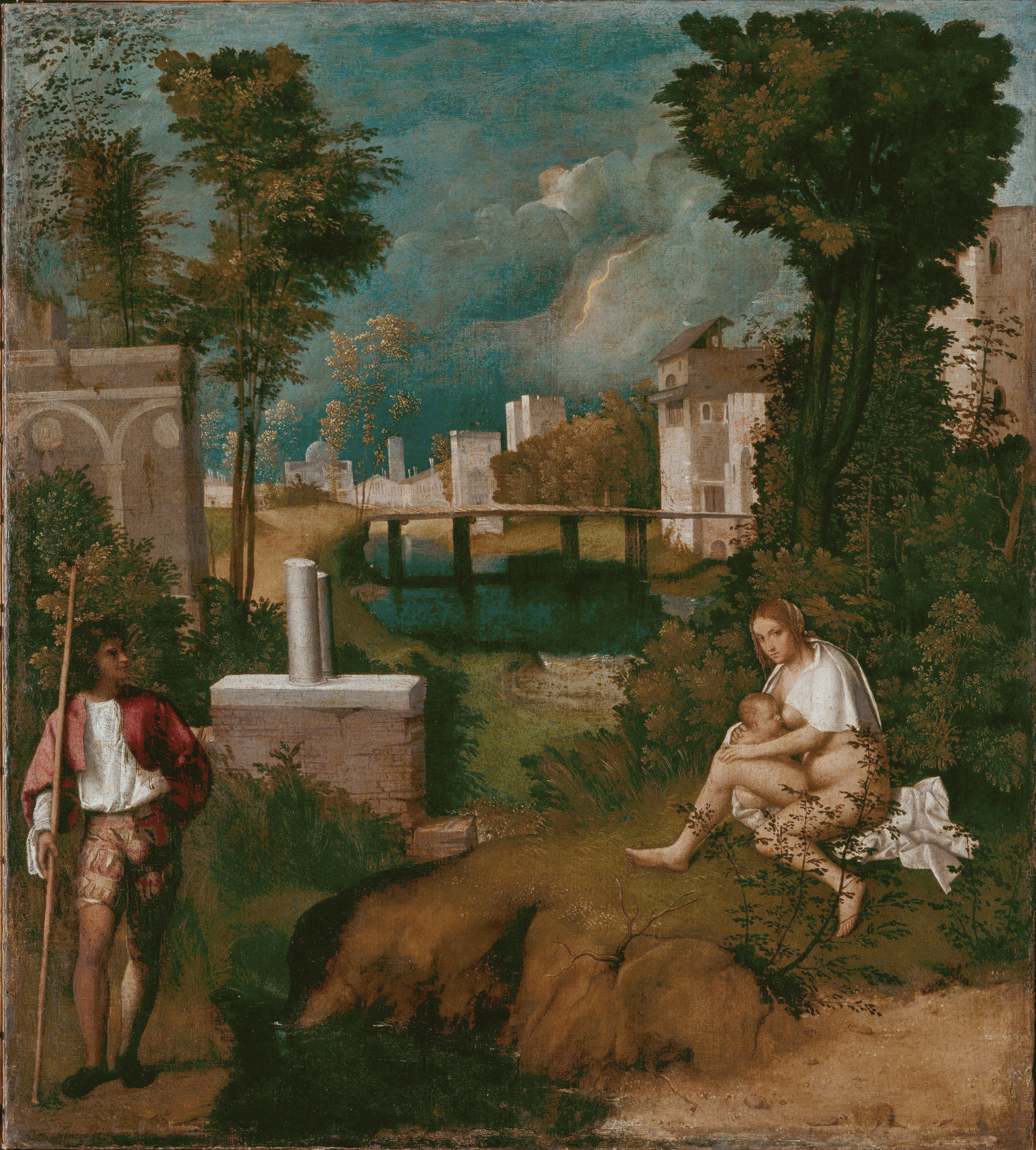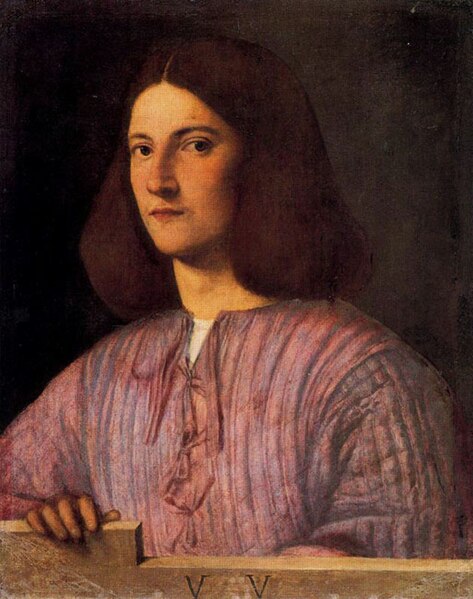Giorgione Barbrelli da Castelfranco, (Giorgione)
kjs on 27th May 2022
Giorgio Barbarelli da Castelfranco (1473/74-1510), also known as Giorgione, was an Italian painter from the Venetial School in the city of Venice. He was the founder of the school of Italian Renaissance painting. Giorgio was one of the extremely influential Italian painters of his time. Giorgione lived a short but highly exciting and memorable life. His active painting life was barely 15 years long. Information regarding Giorgio’s life, career, and art is limited only to the extent of historians and what his biographers wrote in their articles and books. Mention of Giorgio’s name in some 16th-century documents that survived the ravages of time is also of some help in this regard. A major source of Giorgione’s life was the compilation by Giorgio Vasari, a biographer, and artist, in his editions in 1550 and 1568. These are the earliest records available.

His Early Life
Giorgione was born in 1477 (1478?) was born in Castelfranco Veneto, a town near Venice in the Republic of Venice, Italy. The naming pattern that prevailed during that period of history in Italy indicates that Giorgione was a large, handsome, and amorous person. The young painter went to Venice in around 1490 to study painting. Giorgione trained under Giovanni Bellini who was the greatest Venetian master at that time. The similarity of Giorgione’s painting style and technique with those of Giovanni Bellini is proof of this fact. Along with Carlo Ridolfi, Giorgione founded the Italian Renaissance school of art. He rose to prominence quite early in life, as early as in his twenties, after meeting the likes of Leonardo Da Vinci during his Venetian visit. Much of Giorgione’s work has vanished in the dark alleys of history.
His Commissions
Historians believe that the commission for executing a painting for being placed in the Audience Hall of the Ducal Palace in 1507 might be the first one that Giorgione received. However, the historians also feel that this commission remained incomplete. Giorgione’s next important public commission was the execution of frescoes on the exterior of the Fondaco dei Tedeschi (The German Exchange). In this fresco painting, Giorgione painted the figures on the facade over the canal. Out of the many paintings and drawings that he made only a few have survived the ravages of time.
Giorgione was at the height of his reputation when the Venetian Republic Government commissioned him to paint a large work. It was the Sala Del Maggior Consiglio in the Palazzo Ducale. But this large painting has not survived long enough to witness the present-day glare. The important among these Giorgione’s works are ‘The Tempest’, ‘The Three Philosophers’, ‘Sleeping Venus’, ‘Boy with an Arrow’, and ‘Shepherd with a Flute’.

His Famous Painting ‘The Tempest’
Many of his paintings were small, apt for being kept in the mansions of wealthy Venetians. Giorgione lived before landscape paintings became popular. His ‘Tempest‘ (1505) is considered the first landscape in western art. ‘The Tempest‘ was a depiction of an evocative pastoral scene and one of his most famous genres in Venitian painting style.

‘The Sleeping Venus’ (1510)
Giorgione’s painting ‘Sleeping Venus‘ was unfinished at the time of his death. Historians are of the opinion that the responsibility of finishing this painting fell on Titian, another of Giorgione’s contemporaries. Titian’s style of adding buildings to the paintings supports the claim that he completed this painting after Giorgione’s death. This is one among the long series of paintings in celebration of the goddess of love in Venetian art. Titian is famous for this style of painting.
‘Judith’ (1505)

Giorgione executed this painting ‘Judith’ around the year 1504. The painting was originally attributed to Raphael. The Russian Hermitage Museum acquired the painting in 1772. This is one of the very few authentic works of Giorgione.
‘Judgement of Solomon’ (1502-1505)
This excellent piece of a painting by Giorgione created between 1502 and 1505 shows King Solomon on the throne, with the court dignitaries and two women at his feet. The two women were claiming their right over the child, also shown on the ground at the centre of the painting. The King’s solution to the problem presented by the two women was highly ingenious and it helped in revealing the truth.
The Paintings of Disputed Origin
Some of the famous paintings of Giorgione are in the middle of disputes regarding their makers. Many historians believe that Giorgione was the actual painter of these masterpieces. There are also others who think that it was Titian who did these paintings. Two such important paintings are ‘Christ Carrying The Cross’, and ‘The Adultress Brought before Christ‘ (1500). ‘Madonna and Child with SS.Roch and Anthony of Padua’ (1505) and Madonna and Child in a Landscape (1504) are some of the other important paintings of Giorgione. ‘Laura‘ is one painting that bears the signature of Giorgione with the date of the year 1506 on the back of the painting.


Giorgione’s Works Completed by Titian
The painting ‘The Sleeping Venus’ was originally the work of Giorgione. Giorgione could not complete the painting before his death in 1510. The painting shows a young nude woman reclining in the countryside. Titian completed the painting after Giorgione’s death. There were very few paintings in Venetial art depicting nude women before ‘The Sleeping Venus’. After the completion of this painting in around 1510, Venice became a major center for the production of nude female images. Titian and many other famous painters followed up the trend set by this painting by painting many such paintings. According to an art expert, Giorgione was intending to present the human element in the same attitude as the landscape. ‘The Sleeping Venus’ is an excellent example of his effort.

Personality
Giorgione was said to be of a calm and loving demeanour. Giorgione loved playing the lute and he was also a poet. He was popular among the ladies and had many friends.
Famous paintings
‘Tempest‘ is probably the most famous of Giorgione’s paintings. This painting is also known as “The Giovanelli Figures,” or “The Stormy Landscape, with the Soldier and the Gipsy”. It is said to be the first western landscape. Verification using radiography showed a female figure that was later replaced by a male figure on one side. A breastfeeding female sits on the other side of the painting. That female figure looks at the viewer while the male looks at her visage. A city is seen in the background at a distance. A storm brews over the city with lightning flashing in the dark blue sky.

His Style of Painting
Characters in Giorgione’s paintings are seen in a dreamy mood. Textures on paintings are too visible. Different layers are clearly visible and might have been popular with the Venetian public at the time.
Influence
According to Giorgio Vasari’s description, there was said to be a great fire in Venice in the Fondaco de’ Tedeschi by the Ponte del Rialto in the year 1504. A large portion of the building and its merchandise were reportedly lost. It was a very conspicuous and well-known building in the city. At that point, the Signora of Venice ordained that the building be rebuilt. Giorgione had gained popularity in Venice by then. He was asked to paint the walls of the building in fresco. Many paintings on fresco were damaged over time. Many of his masterpieces were lost in this way. He was also a close friend of the royals, the queen of Cyprus, of whom he created a portrait titled ‘Judith’.
Giorgione was also a sought-after painter for Italian and Venetian royalty and affluent populations of Italy. He painted subjects mostly from places such as Castelfranco and throughout the territory of Treviso. He had two disciples Sebastiano, the Venetian, and Tiziano Cadore. The latter surpassed him in fame.
His Final Days and Death
Giorgione contracted the plague in 1511 from a lady friend of his who he visited frequently. That lady had been infected and this fact was unknown to him. He died on the island of Lazaretto Nuovo, reportedly of the plague. According to Vasari, Giorgione was 34 years old when he died. He was probably buried with other victims on the island of Poveglia, off Venice, where the lazar-house was situated
Giorgione’s death notice was found with an original sketch by the artist. The inscription reads “1510 Ihs Maria. On the day of 17 September, Giorgione of Castelfranco, a very excellent artist died of the plague in Venice at the age of 36 and he rests in peace”.
In 2017, on the last page of this 1497 copy of Dante’s Divine Comedy, Library staff at the University of Sydney discovered a death notice of the artist in the form of an ink inscription written above a red chalk sketch by Giorgione of the Madonna and child.

References
http://www.travelingintuscany.com/art/giorgiovasari/lives.pdf





